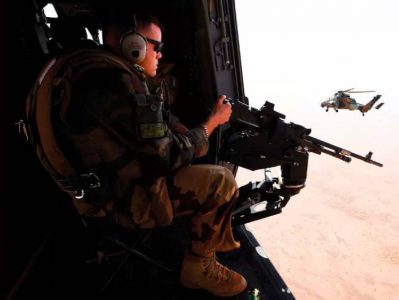
Islamic State and Al-Qaeda terrorist groups menace Africa
Colonel Alain Bayle, erstwhile French military attaché in London, with whom I shared a few confidences, intimated recently that it was whispered within the corridors of power in the Élysée Palace that Europe “faces a 400-year war against militant jihadists” in Africa.
Bayle’s grim words may seen exaggerated but they reflect an even grimmer reality. What had started as a fairly limited upheaval in Mali in 2012 has bloomed into a major conflagration that is threatening to engulf not only the Sahelian states but much of West Africa as well.
Terror attacks in Mali have increased exponentially in the past two years. In 2019, a total of 268 attacks were recorded in that Sahelian state compared with 160 in 2018; fatalities rose from 310 in 2018 to 869 the following year.
It is much worse in Burkina Faso where there has been a 441.8% increase in fatalities between 2018 and 2019, coupled with double the number of attacks in the same period.
The total death toll over the past two or three years now stands at over 4,000 and counting. The UK’s Guardian newspaper says: “In the past year, attacks on civilians have surged, triggering a tenfold increase in displaced people, whose numbers rival those of Syrians from Idlib and Myanmar’s Rohingya. According to official records, nearly 800,000 Burkinabé people had fled their homes as of 29 February. But not all are being registered, and aid groups say the number is far greater.”
François Lecointre, head of the French Armed Forces, said that “if we allow chaos to take root, the [West African] Sahel nations will collapse on themselves, leaving a void for the Islamic State.”
To prevent this, the air forces of more than a dozen nations are now involved, making the Sahel one of the most militarily active regions on the planet.
The number of daily strike and support missions out of cities like Bamako, N’Djamena, Niamey, Baledogle in Somalia and Bangui – as well as several forward airfields in Cameroon, the Central African Republic and elsewhere – now exceeds all of those taking place on a daily basis in Syria and Afghanistan combined.
The Sahel, the vast semi-desert region that stretches halfway across West Africa, is now home to numerous al-Qaeda (AQ) and ISIS aligned groups.
In addition to seemingly random attacks on civilians, especially in Burkina Faso, there have been several strategically selected targets, for example La Terrasse Bar in Bamako, Mali on 7 March 2015, the Radisson Blu Hotel, also in Bamako, on 20 November 2015, and the Splendid Hotel in Ouagadougou, Burkina Faso on 15 January 2016, followed by assaults in Arlit and Agadez in Niger.
Also notable – because it took place in a new and distant region from those that went before – was the bombing of tourist targets in Côte d’Ivoire’s Grand-Bassam, a seaside resort on the coast south of Abidjan in March 2016. East Africa – Kenya specifically – has also had its share of atrocities.
What is significant is that in West Africa, each of these actions has a single thread in common: all were initiated by the same insurgent group, al-Qaeda in the Islamic Maghreb (AQIM) and its local brigade al-Mourabitoune, led by one of the boldest and most remarkable revolutionaries of our times, Mokhtar Belmokhtar.
Also known as the ‘One-eyed Nelson’ (he lost the other while handling explosives in the war with the Mujahadeen in Afghanistan, where he served with distinction) Belmokhtar has been convicted of fomenting revolution in several African states as well as smuggling weapons.
To give him his dues, this guerrilla leader is an astute and remarkably canny military tactician. He has survived many attempts on his life and often been declared killed in action, several times by French military intelligence.
In Algeria, the country of his birth, he was twice convicted and sentenced to death under separate charges by Algerian courts, both times in absentia: in 2007 for terrorism and in 2008 for murder.
Among contemporary revolutionaries active in Africa and the Middle East, Belmokhtar has arguably achieved more victories against what he refers to as ‘the Infidel’ than any of his peers.
He not only plans every attack himself but has been personally involved in many of them. His role within AQIM is regarded as the high point of his career.
Belmokhtar started young. After fighting in Central Asia, he joined a new splinter group, the militant Islamist, Algeria-based Salafist Group for Preaching and Combat (GSPC), later renamed AQIM.
In this he has been so successful that there are currently 55 nations battling this insurgency in West Africa, the majority, apart from France, under the auspices of the UN and with a total UN ‘Peacekeeping’ budget in excess of a billion dollars annually.
MINUSMA, the UN Multidimensional Integrated Stabilisation Mission, headquartered in Bamako, the capital of Mali, is at the core of such efforts.
Established by a Security Council resolution in April 2013 to support political processes in that country, it handles a variety of security-related tasks, the majority of which have involved open warfare against Belmokhtar’s recruits, some of whom come from as far afield as Dagestan in Russia’s Caucasus, and Saudi Arabia.
But compounding the issue is the fact that AQ and ISIS are not the only jihadist organisations currently active in West Africa. The most prominent are:
– Jamaat Nusrat al-Islam wal-Muslimin (JNIM) – an alliance of jihadist groups, active throughout the Sahel region
– The Islamic State in the Greater Sahara (ISGS) – affiliated to Islamic State and active in north-eastern Mali
– Ansarul Islam – deployed in northern Burkina Faso but with links to both AQIM and Nigeria’s Boko Haram.
– Boko Haram – present in north-eastern Nigeria, Niger, Chad and northern Cameroon
According to Judd Devermont, director of the Africa programme at the Center for Strategic and International Studies (CSIS), each one of these groupings is extraordinarily adept at exploiting regional government mistakes, including human rights abuses and a failure to invest in communities that are clearly vulnerable.
Ranged against them are a number of foreign interests that have entered the fray, some from halfway across the globe from where the action is taking place. Just about every major power in Europe is contributing towards air assets – the majority, like Germany, Sweden, Britain, the United States and others in support roles.
The French Air Force remains the most active, operating its fighter jets out of its headquarters at N’Djamena in Chad. Britain, Canada and others are also participating with Chinook CH-47s ‘heavies’ in providing front-line support out of Operation Barkhane’s main operational base at Gao in northern Mali.
Curiously, even the United Arab Emirates has become involved, setting up a veritable air bridge early in 2020 to deliver 30 Streit armoured troop transport vehicles to the Malian Armed Forces in Bamako. The German Streit Group is the world’s largest armoured vehicle manufacturer.
By donating these vehicles, Abu Dhabi is attempting to limit Qatar’s influence over Mali, since it is also providing Streit with sales opportunities among member countries of the French-led G5 Sahel joint military force, which, apart from Mali, includes Mauritania, Burkina Faso, Chad and Niger.
Other governments now involved include Cameroon, attempting to cope (not always successfully) with a double-headed insurgency by combating Nigeria-based Boko Haram along its north-western frontier and trying to halt infiltration of the Central African Republic from Sudan, and Chad in the north-east. It resists as best it can with the Cameroonian Rapid Intervention Battalion (BIR) – created several years ago by former Israeli officers – taking the lead.
Well-trained and coordinated, its troops are deployed along the country’s frontiers, but have not been permitted follow-up rights by the Abuja government, except over short distances during combined operations with Nigerian ground and air forces.
Thanks to images transmitted by portable drones and sometimes, following information provided by Nigerian soldiers, Cameroonian artillery is now able to fire on terrorist groups. Its French-built 155mm guns have several times struck at Boko Haram camps some 10km from the border.
While the Middle East has been the traditional epicentre of jihadist extremism, in recent years, it has become clear that the pendulum has swung to Africa.
As things stand, much of Somalia remains ungovernable and Boko Haram’s attacks extend well beyond Nigeria into the Niger Republic and Chad, aside from Cameroon.
Source: New African Magazine





